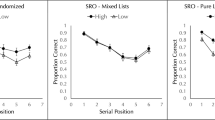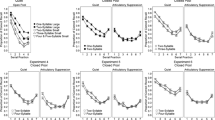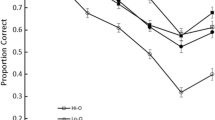Abstract
Attributes of words, such as frequency and imageability, can influence memory for order. In serial recall, Hulme, Stuart, Brown, and Morin (Journal of Memory and Language, 49(4), 500–518, 2003) found that high-frequency words were recalled worse, and low-frequency words better, when embedded in alternating lists than pure lists. This is predicted by associative chaining, wherein each recalled list-item becomes a recall-cue for the next item. However, Hulme, Stuart, Brown, and Morin (Journal of Memory and Language, 49(4), 500–518, 2003) argued their findings supported positional-coding models, wherein items are linked to a representation of position, with no direct associations between items. They suggested their serial-position effects were due to pre-experimental semantic similarity between pairs of items, which depended on frequency, or a complex tradeoff between item- and order-coding (Morin, Poirier, Fortin, & Hulme, Psychonomic Bulletin Review, 13(4), 724–729, 2006). We replicated the smooth serial-position effects, but accounts based on pre-existing similarity or item–order tradeoffs were untenable. Alternative accounts based, on imageability, phonological and lexical neighbourhood sizes were also ruled out. The standard chaining account predicts that if accuracy is conditionalized on whether the prior item was correct, the word-frequency effect should reappear in alternating lists; however, this prediction was not borne out, challenging this retrieval-based chaining account. We describe a new account, whereby frequency influences the strengths of item–item associations, symmetrically, during study. A manipulation of word-imageability also produced a pattern consistent with item–item cueing at study, but left room for effects of imageability at the final stage of recall. These findings provide further support for the contribution of associative chaining to serial-recall behaviour and show that item-properties may influence serial-recall in multiple ways.





Similar content being viewed by others
Notes
Due to sound-driver problems.
We reran the main analyses with a more generous scoring criterion, adapted from a method used by Madan, Glaholt, and Caplan (2010), that used the UNIX spell-checker, aspell, to give credit when the correct item was found within the list of suggested “corrections” offered. This set of analyses did not alter the pattern of findings; all significant effects remained significant and all non-significant effects remained non-significant. Thus, spelling errors had a very minimal influence on the results, perhaps in part due to our matching of the word pools on word length, bigram frequency, and orthographic neighborhood.
Because lenient-scored data produced the same pattern of significant and non-significant effects, we report analyses only for strict scoring.
An initial ANOVA with design Rate[2,4 s] ×Property[Frequency, Imageability] ×List[Pure, Mixed] ×Item[High, Low] found no significant interactions with Rate (p>0.1), indicating that memory was qualitatively similar for both presentation rates. The main effect of Property was non-significant, suggesting that the word pools were well matched for overall difficulty. We therefore analyze word-frequency and imageability separately and present data collapsed across presentation rates.
At face-value, this account does not seem applicable to word-frequency and imageability manipulations. Furthermore, our high-frequency pairs and Hulme et al.’s (2003) had the greatest similarity, so a closed-loop rule may wrongly predict an inverted word-frequency effect for pure lists.
References
Baayen, R., Piepenbrock, R., Gulikers, L. Linguistic Data Consortium, University of Pennsylvania [Distributor], Philadelphia (1995)
Baddeley, A.D., How does acoustic similarity influence short-term memory? Quarterly Journal of Experimental Psychology 20(3):249–264, 1968.
Brown, G.D.A., Preece, T., Hulme, C., Oscillatory-based memory for serial order. Psychological Review 107(1):127–181, 2000.
Burgess, N., and Hitch, G.J., Memory for serial order: A network model of the phonological loop and its timing. Psychological Review, 106(3), 551–581, 1999.
Caplan, J.B., Associative isolation: Unifying associative and order paradigms. Journal of Mathematical Psychology 49(5):383–402, 2005.
Criss, A.H., Aue, W.R., Smith, L., The effects of word frequency and context variability in cued recall. Journal of Memory and Language 64(2):119–132, 2011.
Farrell, S., Temporal clustering and sequencing in short-term memory and episodic memory. Psychological Review 119(2):223–271, 2012.
Farrell, S., Hurlstone, M.J., Lewandowsky, S., Sequential dependencies in recall of sequences: Filling in the blanks. Memory & Cognition 41(6):938–952, 2013.
Farrell, S., and Lewandowsky, S., Dissimilar items benefit from phonological similarity in serial recall. Journal of Experimental Psychology: Learning, Memory, and Cognition 29(5):838–849, 2003.
Geller, A.S., Schleifer, I.K., Sederberg, P.B., Jacobs, J., Kahana, M.J., PyEPL: A cross-platform experiment-programming library. Behavior Research Methods 39(4):950–958, 2007.
Henson, R.N.A., Short-term memory for serial order: The Start-End Model. Cognitive Psychology 36(2):73–137, 1998.
Henson, R.N.A., Norris, D.G., Page, M.P.A., Baddeley, A.D., Unchained memory: Error patterns rule out chaining models of immediate serial recall. Quarterly Journal of Experimental Psychology 49A(1):80–115, 1996.
Howard, M.W., and Kahana, M.J., Contextual variability and serial position effects in free recall. Journal of Experimental Psychology: Learning, Memory, and Cognition 25(4): 923– 941, 1999.
Hulme, C., Stuart, G., Brown, G.D.A., Morin, C., High- and low-frequency words are recalled equally well in alternating lists: evidence for associative effects in serial recall. Journal of Memory and Language 49(4):500–518, 2003.
Humphreys, M.S., Bain, J.D., Pike, R., Different ways to cue a coherent memory system: A theory for episodic, semantic, and procedural tasks. Psychological Review 96(2):208–233, 1989.
Hurlstone, M.J., Hitch, G.J., Baddeley, A.D., Memory for serial order across domains: An overview of the literature and directions for future research. Psychological Bulletin 140(2):339–373, 2014.
Kahana, M.J., Associative symmetry and memory theory. Memory Cognition 30(6):823–840, 2002.
Kahana, M.J., Foundations of human memory. New York: Oxford University Press, 2012.
Kahana, M.J., Mollison, M.V., Addis, K.M., Positional cues in serial learning: The spin-list technique. Memory & Cognition 38(1):92–101, 2010.
Landauer, T.K., and Dumais, S.T., A solution to Plato's problem: The latent semantic analysis theory of acquisition, induction, and representation of knowledge. Psychological Review 104(2):211–240, 1997.
Lewandowsky, S., and Farrell, S., Short-term memory: New data and a model. Psychology of Learning and Motivation: Advances in Research and Theory 49(1):1–48, 2008.
Lewandowsky, S., and Murdock, B.B., Memory for serial order. Psychological Review 96(1):25–57, 1989.
Loftus, G.R., and Masson, M.E.J., Using confidence intervals in within-subject designs. Psychonomic Bulletin Review 1(4):476–490, 1994.
Madan, C.R., Glaholt, M.G., Caplan, J.B., The influence of item properties on association-memory. Journal of Memory and Language 63(1):46–63, 2010.
Miller, L.M., and Roodenrys, S., The interaction of word frequency and concreteness in immediate serial recall. Memory & Cognition 37(6):850–865, 2009.
Morin, C., Poirier, M., Fortin, C., Hulme, C., Word frequency and the mixed-list paradox in immediate and delayed serial recall. Psychonomic Bulletin Review 13(4):724–729, 2006.
Murdock, B.B., A theory for the storage and retrieval of item and associative information. Psychological Review 89(6):609–626, 1982.
Murdock, B.B., and Franklin, P.E., Associative and serial-order information: Different modes of operation? Memory & Cognition 12(3):243–249, 1984.
Rehani, M., and Caplan, J.B., Interference and the representation of order within associations. Quarterly Journal of Experimental Psychology 64(7):1409–1429, 2011.
Saint-Aubin, J., and Poirier, M., Word frequency effects in immediate serial recall: Item familiarity and item co-occurrence have the same effect. Memory 13(3/4):325–332, 2005.
Serra, M., and Nairne, J.S., Part-set cueing of order information: Implications for associative theories of serial order memory. Memory & Cognition 28(5):847–855, 2000.
Solway, A., Murdock, B.B., Kahana, M.J., Positional and temporal clustering in serial order memory. Memory & Cognition 40(2):177–190, 2012.
Stuart, G., and Hulme, C., The effects of word co-occurrence on short-term memory: associative links in long-term memory affect short-term memory performance. Journal of Experimental Psychology: Learning, Memory, and Cognition 26(3):796–802, 2000.
Tse, C.-S., The role of associative strength in the semantic relatedness effect on immediate serial recall. Memory 17(8):874–891, 2009.
Walker, I., and Hulme, C., Concrete words are easier to recall than abstract words: evidence for a semantic contribution to short-term serial recall. Journal of Experimental Psychology: Learning, Memory, and Cognition 25(5): 1256–1271, 1999.
Author Note
We thank Alec Solway and Michael Kahana for valuable feedback on the manuscript. Supported by the Natural Sciences and Engineering Research Council of Canada.
Author information
Authors and Affiliations
Corresponding author
Rights and permissions
About this article
Cite this article
Caplan, J.B., Madan, C.R. & Bedwell, D.J. Item-properties may influence item–item associations in serial recall. Psychon Bull Rev 22, 483–491 (2015). https://doi.org/10.3758/s13423-014-0701-7
Published:
Issue Date:
DOI: https://doi.org/10.3758/s13423-014-0701-7




